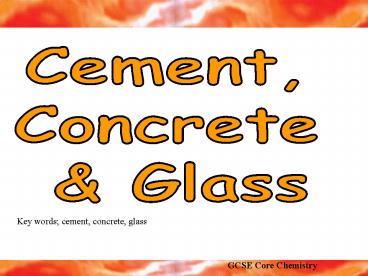Cement, - PowerPoint PPT Presentation
1 / 9
Title:
Cement,
Description:
Making concrete Aim: ... Transparent, translucent, brittle, hard, semi-solid Mortar Mortar made with cement & sand is stronger & sets faster than lime mortar. – PowerPoint PPT presentation
Number of Views:109
Avg rating:3.0/5.0
Title: Cement,
1
Cement, Concrete Glass
Key words cement, concrete, glass
2
Learning Objectives By the end of the lesson I
can
- Describe how cement is made and what is used to
make it - Describe how glass is made.
- Identify that Limestone and its products have
many uses, including slaked lime, mortar, cement,
concrete and glass. - Evaluate the developments in using limestone,
cement, concrete and glass as building materials,
and their advantages and disadvantages over other
materials.
3
starter
Cement
Cement is made by strongly heating a mixture of
limestone clay before turning it into powder.
Opaque, Hard.
If you were to draw up a table to explain the
differences in these substances, what headings
would you use?
Concrete
Concrete is made by mixing cement with sand,
stones or crushed rock (gravel) water. This can
be poured into moulds or spread out before it
sets to produce different shapes. It can be
reinforced by pouring it around steel. Opaque,
Hard
Glass
Glass can be made by from limestone, sand and
sodium carbonate (Soda). Transparent,
translucent, brittle, hard, semi-solid
Mortar
Mortar made with cement sand is stronger sets
faster than lime mortar. It sets under water or
in rain.
4
Making concrete
- Aim To make concrete of different strengths
- Equipment
- ????
- Method
- ?????
- In your groups decide on 3 strengths of concrete
to make and then be tested using weights when
dry. You will need to predict which will be
stronger and why and explain how you plan on
testing the strength
5
- THINK
- about life without limestone products
- Which product would you miss the most. Why?
- PAIR
- Your thoughts with your partner
- SHARE
- Share your thoughts with the class
6
TRUE or FALSE
starter
- Lime mortar can set underwater
- The roman method for making underwater mortar was
used in the seventeenth century - Portland cement is a mixture.
- Recent developments in glass are allowing
building innovations. - Concrete is poor at resisting forces.
FALSE
TRUE
TRUE
TRUE
FALSE
7
- Aim To test the strength of a concrete mixture
- Method
- Place two stools 5 cm apart and place your first
beam over the gap between them (see picture
overslide). - a) Using a piece of strong string, hang a 100 g
mass holder from the beam. - b) The diagram below gives some idea of how the
set-up should look. - c) The mass holder should be close to the floor
and if possible have some newspapers under it so
that when it drops it does not damage the floor!
8
- Gradually add 100 g masses at a time to the mass
holder until the beam snaps. - Make up a results table and record your results
in the table. Remember 100 g is equivalent to a
1N force! - Repeat 15 with the other moulds.
9
Learning Objectives By the end of the lesson I
can
- Describe how cement is made and what is used to
make it - Describe how glass is made.
- Identify that Limestone and its products have
many uses, including slaked lime, mortar, cement,
concrete and glass. - Evaluate the developments in using limestone,
cement, concrete and glass as building materials,
and their advantages and disadvantages over other
materials.






























